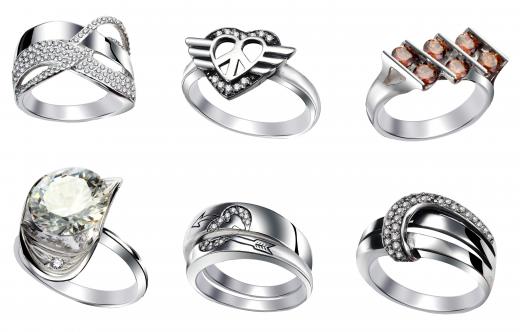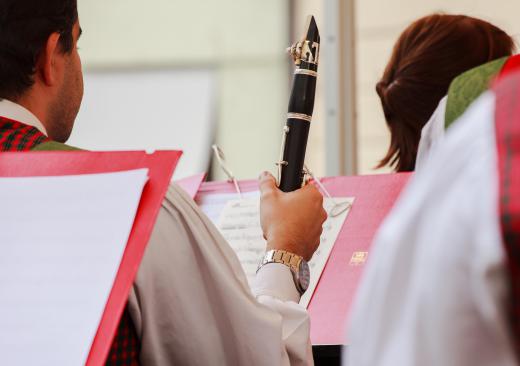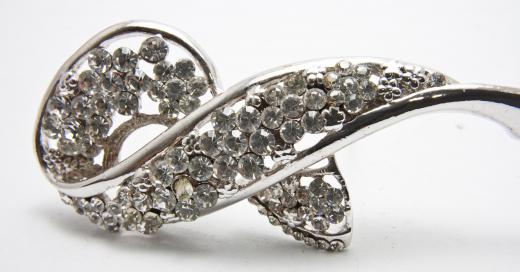What is Alpaca Silver?
 Jessica Ellis
Jessica Ellis
Alpaca silver is a common name for a metal alloy, a combination of metals, of copper, nickel and occasionally other metals such as zinc, tin, lead or cadmium. The alloy also can be called nickel silver, German silver, new silver and paktong. It is used in a variety of manufactured commercial products, as well as in technical industries.
Alpaca silver was first used in China as a substitute for sterling silver. It made its way into Europe through traded goods, where it was marketed under the name of paktong or white copper. In the 18th century, several German companies adopted the use of a similar alloy, and in 1823 a competition was held to discover which alloy was the best silver imitation. Berndorf, a German manufacturer, sold their nickel silver products under the name Alpaca silver, and the term became commonly used throughout Europe. In 1840, a process called electroplating was developed, allowing a fine metal coating to be plated onto metal and non-metal object, which opened many new markets for nickel silver-plated goods.

For many years, this silver was a component in several European coins, including the Portuguese escudo and the German mark. With the shift in currency to the Euro, these coins are now effectively out of circulation. A form of the alloy is also used in the U.S. nickel, although the composition of 75% copper and 25% nickel is called copper-nickel in America.

In some forms of composition, Alpaca silver is found in industrial and technical machinery. The alloy can be found in various components for boats, and is useful in plumbing, due to its corrosion-resistant composition. It is also used in heating coils, as the metal combination is highly resistant to electricity.
In commercial products, this silver is frequently found in musical instruments. A nickel silver saxophone is considered to have an exceptionally powerful sound, and many popular manufacturers carry at least one model. Because nickel silver needs no lacquering, it is the most common material used for the keys on woodwinds. Oboes, clarinets and bassoons are all likely to have silver components.

Because of its visual similarity to sterling silver, Alpaca silver is frequently used in jewelery as a less expensive alternative to true silver. Its stainless finish makes the jewelery easy to clean, requiring only lemon juice or a mild soap to remove any marks or tarnishing. Alpaca silver is popular with South American jewelry companies and is used to create beautiful, traditional and modern pieces.
AS FEATURED ON:
AS FEATURED ON:













Discussion Comments
Is there a way or data base for dating alpaca mexico stamped jewelry? Have a pair of March alpaca Mexico clip on earrings with chip Bluestone and Abalone flower inlay.
Just bought a brooch marked Alpaca Mexico. Looks like silver and reacts to test acid like silver, conclusion it is silver! Acid tests don't lie. If in doubt, test the article.
I have read all the posts on here. I am not a silversmith, but I have collected jewelry for 30-plus years. Alpaca, as understood by books and silversmith's information, does have some silver content. It is an alloy, as are gold and sterling, because they are not 100 percent pure! This is the definition of an alloy!
Anyway, it does contain some silver! As for allergic reactions: if you do not have a reaction to Alpaca marked jewelry, then that tells you that the nickel content is very very low! When Alpaca jewelry is made in different countries, the mixes of the metals can be different, thus there can be an allergic reaction to some Alpaca marked jewelry as opposed to other jewelry. Read up, people! The information is there; you must do your research rather than just comment! Note: I have an allergic reaction to some items saying, "nickel free"!
I've recently acquired my grandmother's silver set and other items. I know they were stationed in Germany during World War II, which is where most of her belongings are from. One creamer says Alpaka with a K instead of a C. What is this?
@anon324661: Of course it's an alloy. Sterling silver is an alloy, too. Alloy means a combination of two or more metals. Sterling silver is only 92.5 percent silver; the other 7.5 percent is often mostly or entirely copper, but may include zinc, platinum, nickel, or other metals.
@anon17629: Nickel is the metal in jewelry most likely to cause an allergic reaction. It's relatively rare for sterling silver to contain nickel. Karat gold always contains nickel, as does this "alpaca silver," which is also called "nickel silver."
I am a legally licensed appraiser of antiques and collectibles who has worked with such major auction houses as Skinners and Christies - and have noted yes, some alloy jewelry marked alpaca, but have found also some of sterling quality marked Alpaca, and am getting rather annoyed by some who comment it is only alloys.
I am thinking sometimes that some of the people posting are continuing gossip they have heard from other sites.
Please continue to actually test anything marked Alpaca as some is indeed sterling quality!
I am allergic to anything but gold or sterling, but I wear Alpaca silver jewelry from Peru and it never breaks me out. If there's even a little discoloration, it comes right off with lemon juice. I think it's very pretty with native stones in necklaces.
It should be illegal to call this "silver" since it has no silver whatsoever! What are they thinking? Nickel is the source of all jewelry skin rashes a.k.a. allergies. I just saw this item on ebay. I thought it was sterling silver with alpaca designs since it's from Peru and it does say "llama".
I am in search of buying taxco mexico men's heavy link bracelets, the ones with the large slightly curved box clasp and I am having a heck of a time finding wholesalers, retailers, manufacturers -- you name it. But where the heck or how the heck can I locate these folks? I envision a showroom with many many styles in multiples hanging all around the walls like we have all see at jewelry shows..but I have never been to Taxco, so I am unfamiliar with these places. Can you help me?
Might even want to go there and stock up our store with them, but first I have to find them!
I sell Peruvian Alpaca Silver Jewelery. I am aware it's meant to be hypoallergenic so it should have a lower chance of causing allergic reactions in people with allergies.
I have a nickel allergy. I get a rash on my finger if I wear gold or anything containing nickel, and earrings make my earlobes sore. I have to wear stainless, platinum or sterling. Hope this helps!
This metal, if used as a silver substitute in manufacturing products, might affect the price of silver as it is an industrial metal. Silver has over 10,000 uses.
Alpacca is a trademark of Berndorf, Germany, from 1840 on. It is mainly copper, with added nickel and zinc. No silver at all. It sure is poisonous on the long run.
It looks like dull silver, but is stronger and much cheaper. It is produced in several countries in Europe.
I also have a spoon with the Alpaca gbf mark, marked with a name Mona e valle. Is this a style name?
I used to live for decades in Mexico and have bought both sterling, "alpaca" and "alpaca plateada". In Mexico, the understanding is that the "alpaca" is an alloy made up of metals including some silver. So, when there is "alpaca" which is then silverplated, this is better or heavier than just any base/underlying metal that is silverplated. Mexicans will first buy alpaca plateada before just "plateado".
To me it is just a cheap imitation of silver. Don't look a gift horse in the mouth, but I ask, "Am I not at least worth silver?"
I have some dinner flatware that is marked "Alpacca G.B.F.". Can you tell me from where it originates?
Thank you.
I would like to know what Prima Alpaca is? Is it silver plated Alpaca, or just a name enhancement?
try legor group alloy code alpcast or ottwm for replacing alpaca silver and its technically and dermatologically better.
Alpaca is not just from Mexico and it does not contain lead.
I am looking for a U.S. distributor of sheets of Alpaca silver. Any help with sources is appreciated.
is there lead in alpaca silver flatware?
it has lead?? is it safe?
I always believed that modern jewelery (1970's to present) with alpaca on it is made in Mexico...It often has *Alpaca Mexico* marked on it. Sue
I'd like to know about possible allergic reactions on the metal: nickel.
Post your comments